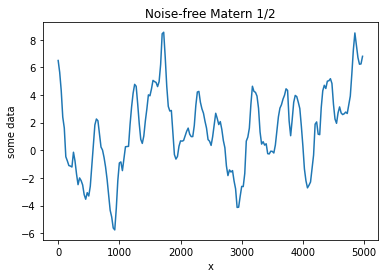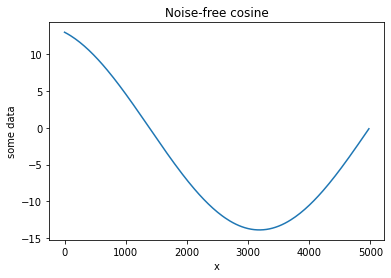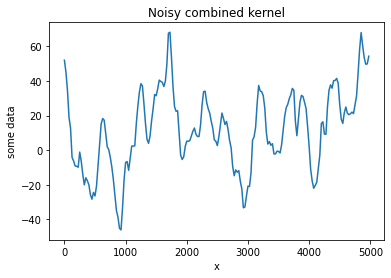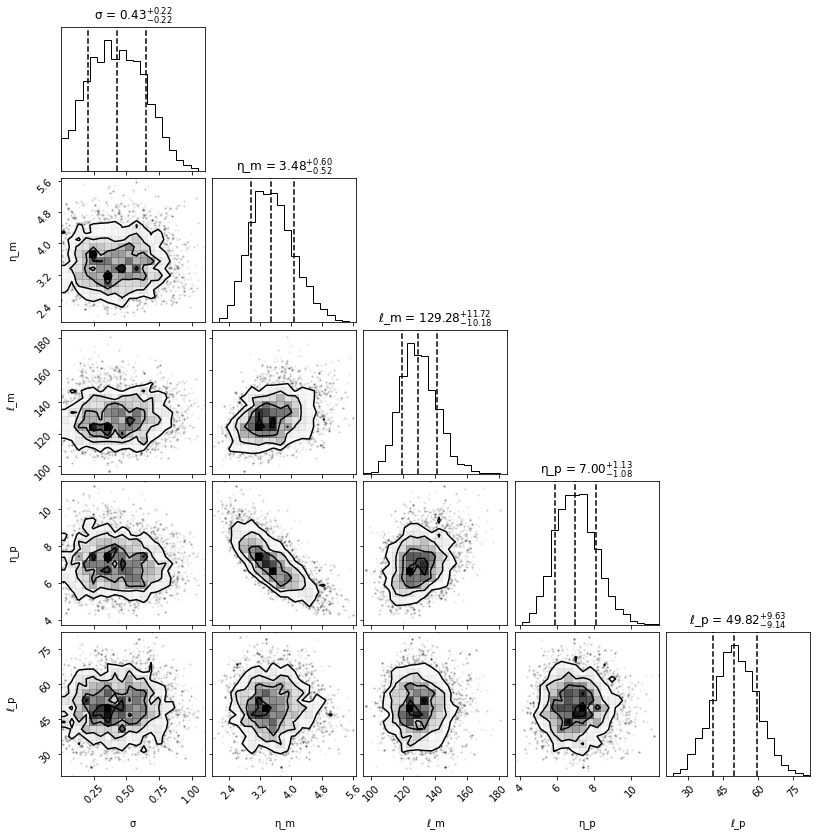1D parameter estimation using MCMC: kernel multplication#
This example will cover:
Use MCMC to infer kernel paramaters
Finding sample with highest log-prob from the mcmc chain
Visualising results of sampling
Making predictions
[1]:
from gptide import cov
from gptide import GPtideScipy
import numpy as np
import matplotlib.pyplot as plt
import corner
import arviz as az
from scipy import stats
from gptide import stats as gpstats
Generate some data#
[2]:
####
# These are our kernel input parameters
np.random.seed(1)
noise = 0
η_m = 4
ℓ_m = 150
covfunc = cov.matern32_1d
###
# Domain size parameters
dx = 25.
N = 200
covparams = (η_m, ℓ_m)
# Input data points
xd = np.arange(0,dx*N,dx)[:,None]
GP = GPtideScipy(xd, xd, noise, covfunc, covparams)
# Use the .prior() method to obtain some samples
yd = GP.prior(samples=1)
[3]:
plt.figure()
plt.plot(xd, yd)
plt.ylabel('some data')
plt.xlabel('x')
plt.title('Noise-free Matern 1/2')
[3]:
Text(0.5, 1.0, 'Noise-free Matern 1/2')

[4]:
np.random.seed(1)
noise = 0
ℓ_p = 60
η_p = 8
covfunc = cov.cosine_1d
covparams = (η_p, ℓ_p)
# Input data points
xd = np.arange(0,dx*N,dx)[:,None]
GP = GPtideScipy(xd, xd, noise, covfunc, covparams)
# Use the .prior() method to obtain some samples
yd = GP.prior(samples=1)
def sm(x, xpr, params):
η_m, ℓ_m, x_p, ℓ_p = params
return cov.matern32_1d(x, xpr, (η_m, ℓ_m)) * cov.cosine(x, xpr, (x_p, ℓ_p))
[5]:
plt.figure()
plt.plot(xd, yd)
plt.ylabel('some data')
plt.xlabel('x')
plt.title('Noise-free cosine')
[5]:
Text(0.5, 1.0, 'Noise-free cosine')

[6]:
np.random.seed(1)
noise = 0.5
def sm(x, xpr, params):
η_m, ℓ_m, η_p, ℓ_p = params
return cov.matern32_1d(x, xpr, (η_m, ℓ_m)) * cov.cosine_1d(x, xpr, (η_p, ℓ_p))
covfunc = sm
covparams = (η_m, ℓ_m, η_p, ℓ_p)
# Input data points
xd = np.arange(0,dx*N,dx)[:,None]
GP = GPtideScipy(xd, xd, noise, covfunc, covparams)
# Use the .prior() method to obtain some samples
yd = GP.prior(samples=1)
[7]:
plt.figure()
plt.plot(xd, yd)
plt.ylabel('some data')
plt.xlabel('x')
plt.title('Noisy combined kernel')
[7]:
Text(0.5, 1.0, 'Noisy combined kernel')

Inference#
We now use the gptide.mcmc function do the parameter estimation. This uses the emcee.EnsembleSampler class.
[8]:
from gptide import mcmc
n = len(xd)
[11]:
# Initial guess of the noise and covariance parameters (these can matter)
noise_prior = gpstats.truncnorm(0.4, 0.25, 1e-15, 1e2) # noise - true value 0.5
covparams_priors = [gpstats.truncnorm(1, 1, 1e-15, 1e2), # η_m - true value 4
gpstats.truncnorm(125, 50, 1e-15, 1e4), # ℓ_m - true value 150
gpstats.truncnorm(2, 2, 1e-15, 1e4), # η_p - true value 8
gpstats.truncnorm(50, 10, 1e-15, 1e4) # ℓ_p - true value 60
]
samples, log_prob, priors_out, sampler = mcmc.mcmc( xd,
yd,
covfunc,
covparams_priors,
noise_prior,
nwarmup=100,
niter=50,
verbose=False)
Running burn-in...
100%|████████████████████████████████████████████████████████████████████████████████| 100/100 [01:54<00:00, 1.14s/it]
Running production...
100%|██████████████████████████████████████████████████████████████████████████████████| 50/50 [01:00<00:00, 1.20s/it]
Find sample with highest log prob#
[12]:
i = np.argmax(log_prob)
MAP = samples[i, :]
print('Noise (true): {:3.2f}, Noise (mcmc): {:3.2f}'.format(noise, MAP[0]))
print('η_m (true): {:3.2f}, η_m (mcmc): {:3.2f}'.format(covparams[0], MAP[1]))
print('ℓ_m (true): {:3.2f}, ℓ_m (mcmc): {:3.2f}'.format(covparams[1], MAP[2]))
print('η_p (true): {:3.2f}, η_p (mcmc): {:3.2f}'.format(covparams[2], MAP[3]))
print('ℓ_p (true): {:3.2f}, ℓ_p (mcmc): {:3.2f}'.format(covparams[3], MAP[4]))
Noise (true): 0.50, Noise (mcmc): 0.77
η_m (true): 4.00, η_m (mcmc): 3.28
ℓ_m (true): 150.00, ℓ_m (mcmc): 142.82
η_p (true): 8.00, η_p (mcmc): 7.81
ℓ_p (true): 60.00, ℓ_p (mcmc): 48.30
Posterior density plot#
[13]:
labels = ['σ','η_m','ℓ_m','η_p','ℓ_p']
def convert_to_az(d, labels):
output = {}
for ii, ll in enumerate(labels):
output.update({ll:d[:,ii]})
return az.convert_to_dataset(output)
priors_out_az = convert_to_az(priors_out, labels)
samples_az = convert_to_az(samples, labels)
axs = az.plot_density( [samples_az[labels],
priors_out_az[labels]],
shade=0.1,
grid=(1, 5),
textsize=12,
figsize=(12,3),
data_labels=('posterior','prior'),
hdi_prob=0.995)

Posterior corner plot#
[14]:
fig = corner.corner(samples,
show_titles=True,
labels=labels,
plot_datapoints=True,
quantiles=[0.16, 0.5, 0.84])

Condition and make predictions#
[15]:
plt.figure(figsize=(15, 4))
plt.ylabel('some data')
plt.xlabel('x')
xo = np.arange(0,dx*N*1.5,dx/3)[:,None]
for i, draw in enumerate(np.random.uniform(0, samples.shape[0], 100).astype(int)):
sample = samples[draw, :]
OI = GPtideScipy(xd, xo, sample[0], covfunc, sample[1:],
P=1, mean_func=None)
out_samp = OI.conditional(yd)
plt.plot(xo, out_samp, 'r', alpha=0.05, label=None)
plt.plot(xo, out_samp, 'r', alpha=0.1, label='Draws from posterior') # Just for legend
OI = GPtideScipy(xd, xo, 0, covfunc, MAP[1:],
P=1, mean_func=None)
out_map = OI.conditional(yd)
plt.plot(xo, out_map, 'k', label='Noise-free draw from MAP')
plt.plot(xd, yd,'.', label='Obs')
plt.legend()
plt.grid()

[ ]: